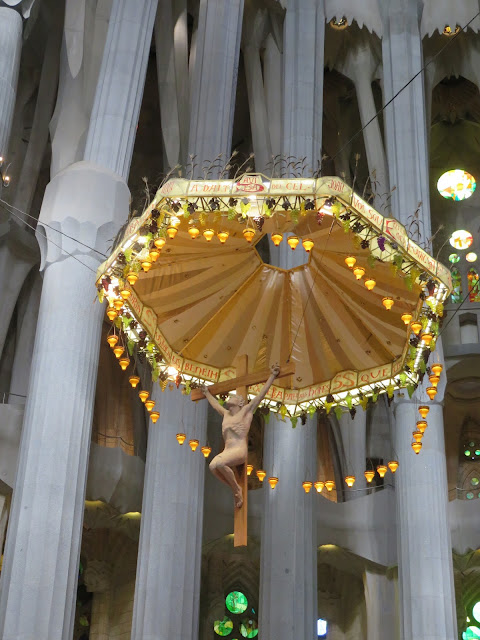Before we left St. Paul, I purchased tickets for a 10:00 a.m. timed entry to Sagrada Familia (SF). I didn't want us to have to get up too early on our first full day of vacation, and I wanted to make sure we had plenty of time for the afternoon naps we would need. In a stroke of good luck, Hotel Actual was a ten-minute walk from SF, and we made sure to leave ourselves plenty of time to grab another bocadillo somewhere along the way. It was a beautiful morning, sunny, bright, and not too hot yet.
A month later, I am still at a loss as to how best to write about Gaudi's masterpiece. For as long as I have known about this basilica (or temple), I have been fascinated by its unfinished state. I get chills thinking about its monumentality and excited by the idea that the construction will be finished in my lifetime. And the details, the details. Every inch inside and out is planned, which I knew before I saw SF but still didn't prepare me for the amount of design that was done by Gaudi. I was relieved to learn that he executed the design in several phases.
As we approached SF along Avenue Diagonal, the first sight was electrifying. You can see the identifiable bell towers but also construction cranes, evidence that work is still underway. Even though you cannot see the construction inside, you can hear the drills and hammers, which is exciting.
The lushly detailed Nativity Facade celebrated the birth of Christ and exhibited some of the more Gothic and more nature-derived design elements. This was the first completed facade (1930), most of which was accomplished in Gaudi's lifetime and thus established his design intent for future architects and builders.
Polychromed plants and insects covered the bronze doors in one of the three Nativity Facade porticoes and represented the joy of nature. Gaudi had intended for all the archivolts and human figures to be colored as well as the plants. I am glad they're not, although I would love to see the rendered drawings. These doors were installed just last year.
The Passion Facade, which has a starker, more modernist, very angular style, was designed to show Christ's suffering. Construction on this facade was begun in the 1950s. Part of one of the six inclined columns, representing a sequoia tree, can be seen on the left.
Christ's foot from the Judas Kiss sculpture, Passion Facade.
The Calvary of Christ above which is the Death of Christ, also Passion Facade. These sculptures are on two tiers, the hierarchy of which was more evident from a few steps back.
Massive bronze doors with thousands of symbols and an unfathomable iconography. I like to think of these as the Dan Brown doors as they would be at home in any of his thrillers populated by secret societies.
And the interior, oh the interior. The verticality was most impressive. The branching columns unmistakably resembled trees and gave the overall effect of being in a forest clearing. The pale concrete columns and arches and other vertical surfaces ensured that colors from the stained glass were reflected onto them. Since our visit coincided with a full-on shining sun, no-cloud day, the color was splendid and vibrant.
The crossing
The canopy over the altar with glass vines and grapes and a Latin cross.
Stained glass. This side is primarily yellows, oranges, reds.
A rose window. Near perfect gradation from blues/purples at top to blues/green in the middle and yellow/orange at bottom.
Colorful reflections
Of the 18 planned towers, eight are finished--four on each of the Nativity and Passion facades--and two--one on each facade--are open to the public. Our ticket included an opportunity to tour a tower. From home, without doing any research, I chose one at random, the Passion Facade. We took a small elevator to the viewing stations at the near top of the tower. We were able to see recently completed portions that were still protected by a scrim of some sort.
City views framed by one of the bell tower's tiny cutout windows.
Crowning elements covered in colored glass and tile. The ears of corn and grape bunches symbolized the Eucharist's bread and wine (body and blood of Christ).
Tile-covered medallions. Two familiar little faces peeked out about as far as they dared. We were really, really, really high up over the street. Fortunately, we were able to take the elevator down. Had we chosen the Nativity Facade, we would have had to walk down the stairs.
Each of us was affected by Sagrada Familia. John, who has seen countless churches and cathedrals as the child of an art historian, said he'd never seen anything like this. Winston asked if we could just sit for a while and take it all in. We all vowed to return in 2026 upon its completion. In the meantime, I look forward to following the construction of the remaining towers, domes, and the Glory Facade.




















No comments:
Post a Comment